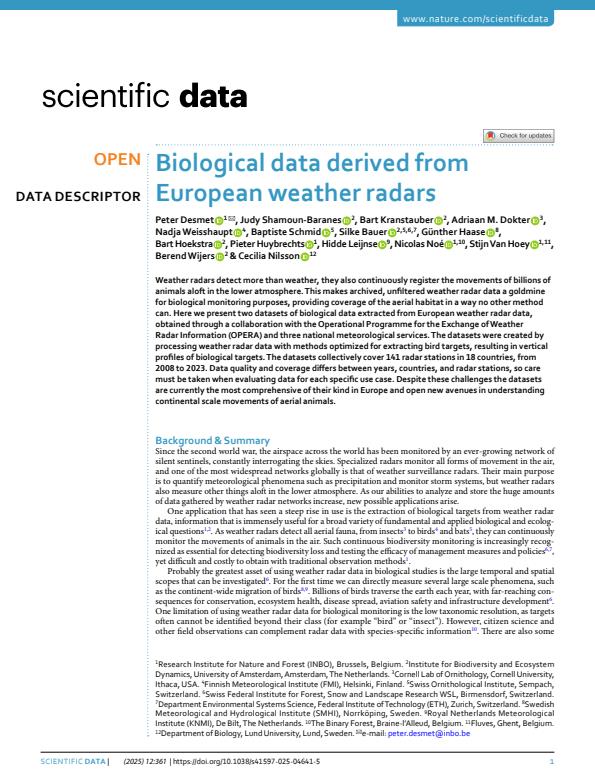Biological data derived from European weather radars
Weather radars detect more than weather, they also continuously register the movements of billions of animals aloft in the lower atmosphere. This makes archived, unfiltered weather radar data a goldmine for biological monitoring purposes, providing coverage of the aerial habitat in a way no other method can. Here we present two datasets of biological data extracted from European weather radar data, obtained through a collaboration with the Operational Programme for the Exchange of Weather Radar Information (OPERA) and three national meteorological services. The datasets were created by processing weather radar data with methods optimized for extracting bird targets, resulting in vertical profiles of biological targets. The datasets collectively cover 141 radar stations in 18 countries, from 2008 to 2023. Data quality and coverage differs between years, countries, and radar stations, so care must be taken when evaluating data for each specific use case. Despite these challenges the datasets are currently the most comprehensive of their kind in Europe and open new avenues in understanding continental scale movements of aerial animals.
Details
| Volume | 12 |
|---|---|
| Magazine issue | 1 |
| Pages (to-from) | 361 |
| Type | A1: Web of Science-article |
| Category | Research |
| Magazine | Scientific Data |
| Issns | 2052-4463 |
| Language | English |
Bibtex
@misc{38366485-8808-4358-8365-12245ec1ad43,
title = "Biological data derived from European weather radars",
abstract = "
Weather radars detect more than weather, they also continuously register the movements of billions of animals aloft in the lower atmosphere. This makes archived, unfiltered weather radar data a goldmine for biological monitoring purposes, providing coverage of the aerial habitat in a way no other method can. Here we present two datasets of biological data extracted from European weather radar data, obtained through a collaboration with the Operational Programme for the Exchange of Weather Radar Information (OPERA) and three national meteorological services. The datasets were created by processing weather radar data with methods optimized for extracting bird targets, resulting in vertical profiles of biological targets. The datasets collectively cover 141 radar stations in 18 countries, from 2008 to 2023. Data quality and coverage differs between years, countries, and radar stations, so care must be taken when evaluating data for each specific use case. Despite these challenges the datasets are currently the most comprehensive of their kind in Europe and open new avenues in understanding continental scale movements of aerial animals.
",author = "Peter Desmet and Judy Shamoun‐Baranes and Bart Kranstauber and Adriaan M Dokter and Nadja Weisshaupt and Baptiste Schmid and Silke Bauer and Günther Haase and Bart Hoekstra and Pieter Huybrechts and Hidde Leijnse and Nicolas Noé and Nicolas Noé and Stijn Van Hoey and Stijn Van Hoey and Berend-Christiaan Wijers and Cecilia Nilsson",
year = "2025",
month = feb,
day = "28",
doi = "https://doi.org/10.1038/s41597-025-04641-5",
language = "English",
publisher = "Instituut voor Natuur- en Bosonderzoek",
address = "Belgium,
type = "Other"
}
Authors
Peter DesmetJudy Shamoun‐Baranes
Bart Kranstauber
Adriaan M Dokter
Nadja Weisshaupt
Baptiste Schmid
Silke Bauer
Günther Haase
Bart Hoekstra
Pieter Huybrechts
Hidde Leijnse
Nicolas Noé
Nicolas Noé
Stijn Van Hoey
Stijn Van Hoey
Berend-Christiaan Wijers
Cecilia Nilsson

